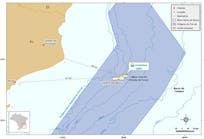Venezuela's Orinoco oil belt made headlines in January with word that the US Geological Survey had assigned the area technically recoverable volumes of 513 billion bbl of heavy oil and 135 tcf of associated-dissolved gas in Miocene sediments.
USGS noted that the Orinoco is the largest accumulation it has ever assessed and is one of the world's largest accumulations of recoverable oil (OGJ Online, Jan. 22, 2010).
Petroleos de Venezuela SA estimated 1.18 trillion bbl of oil in place in the Orinoco in 1987 and revised that in 2006 to a median of 1.3 trillion bbl, a maximum of 1.4 trillion bbl, and a minimum of 900 billion bbl.
The following is a perspective on this enormous resource by an editor who visited the former Hamaca area of the belt in 1983 on a PDVSA educational tour.
Exploration history
Early efforts to produce heavy crude from the belt led PDVSA predecessors to output by the early 1980s of 93,000 b/d.
Of that, 67,000 b/d came from traditional fields just south and east of El Tigre, and 26,000 b/d came from the area farther south between El Tigre and Ciudad Bolivar.
Venezuela's oil reserves at the end of 1982 were 24.6 billion bbl, of which 4.3 billion bbl were attributed to the Orinoco.
Venezuelan consultant Anibal Martinez wrote in 1987 that the Orinoco oil belt extends 285 miles westwards from Puerto Ordaz. The first well was drilled in 1936, and preliminary exploration ended in 1967.
Most of the 58 wells drilled in the next 3 decades weren't tested. Then PDVSA companies drilled 669 wells in 1979-83 totaling 2.1 million ft of hole and shot 9,320 line-miles of seismic.
La Canoa-1, the belt's 1936 discovery well, is 25 miles north-northwest of Ciudad Bolivar. It went to a total depth of 3,855 ft and found 7° gravity oil in tar sands. Giant Temblador field, 93 miles east-northeast, was discovered 9 months later. The first documented geophysical survey, in 1937, covered 130 line-km north of Zuata.
The belt, which underlies more than 4,600 sq miles at the southern end of the Eastern Venezuelan basin, has no significant surface indications of petroleum.
Martinez proposed to designate six main producing areas, which were later consolidated to four: from west to east, Machete, Zuata, Hamaca, and Cerro Negro, that eventually spanned the full 375 miles between Tucupita and Calabozo.
Venezuelan President Hugo Chavez's administration changed the names to Boyaca, Junin, Ayacucho, and Carabobo, respectively.
Cumulative estimates
The lion's share of Orinoco production has come from projects operated by four strategic associations that started up in 1998, 1999, 2000, and 2001.
The Petrozuata, Cerro Negro, Sincor, and Hamaca projects, if each ran at capacity since startup, could have produced no more than 2.1 billion bbl of raw crude by the end of 2009. Venezuela nationalized the projects in 2007.
PDVSA and its predecessor companies likely have not produced even 1 billion bbl from Orinoco, including the Bitumenes Orinoco SA plant that extracted bitumen for the Orimulsion boiler fuel product.
That leaves almost all of the USGS technically recoverable figure in the ground to be produced by the four legacy projects and numerous new ventures now being sanctioned (see map, OGJ, Nov. 21, 2005, p. 54).
PDVSA Pres. Rafael Ramirez said the Orinoco belt is producing more than 532,000 b/d of 16-32° gravity oil (OGJ Online, Jan. 6, 2010).
Last November, Ramirez—who also serves as Venezuela's minister of oil—told the third World Congress on Heavy Oil certified crude reserves in the Orinoco belt are expected to reach 235.6 billion bbl by this year's third quarter and its total reserves 316 billion bbl.
Trend in Colombia
Most maps show the Orinoco belt ending just west of Venezuela's sprawling Aguaro-Guariquito National Park southeast of Calabozo.
Calabozo, Venezuela, is 190 miles north of Venezuela's border with Colombia.
Along that border is Colombia's CPE-3 heavy oil development block in the remote eastern Llanos basin, a 6.4 million acre tract on which ExxonMobil Corp. signed a technical evaluation agreement in 2008. ExxonMobil was to run 2D seismic surveys in 2009 in CPE-3, on trend with the Orinoco belt (OGJ, Apr. 6, 2009, Newsletter).
BHP Billiton and SK Energy hold rights to CPE-5 on 7.9 million acres south of CPE-3, and other companies including Shell, Talisman, KNOC, Pacific Rubiales, and Ecopetrol hold smaller blocks west and southwest of CPE-3 and CPE-5.
More Oil & Gas Journal Current Issue Articles
More Oil & Gas Journal Archives Issue Articles
View Oil and Gas Articles on PennEnergy.com
